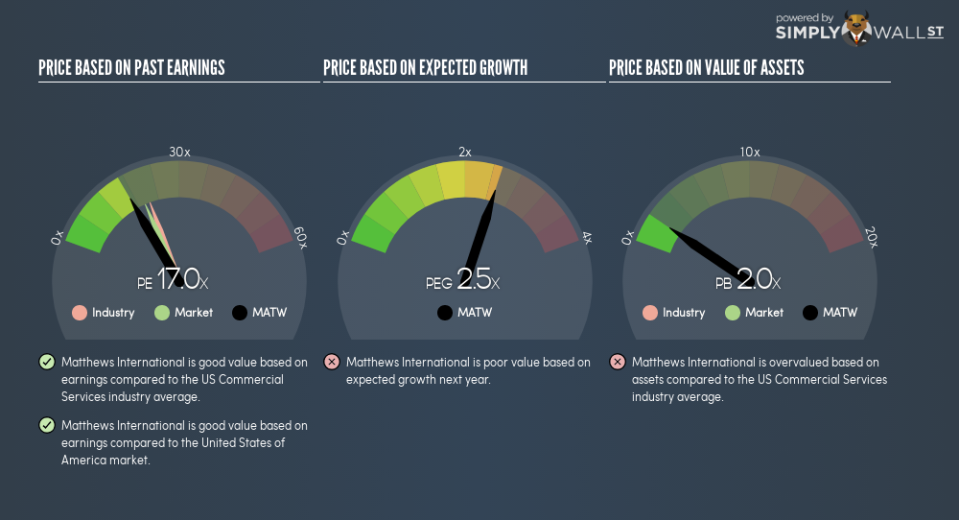What Does Matthews International Corporation’s (NASDAQ:MATW) PE Ratio Tell You?

The content of this article will benefit those of you who are starting to educate yourself about investing in the stock market and want to begin learning about how to value company based on its current earnings and what are the drawbacks of this method.
Matthews International Corporation (NASDAQ:MATW) is trading with a trailing P/E of 17x, which is lower than the industry average of 21.3x. Although some investors may jump to the conclusion that this is a great buying opportunity, understanding the assumptions behind the P/E ratio might change your mind. In this article, I will explain what the P/E ratio is as well as what you should look out for when using it.
See our latest analysis for Matthews International
What you need to know about the P/E ratio
P/E is often used for relative valuation since earnings power is a chief driver of investment value. It compares a stock’s price per share to the stock’s earnings per share. A more intuitive way of understanding the P/E ratio is to think of it as how much investors are paying for each dollar of the company’s earnings.
P/E Calculation for MATW
Price-Earnings Ratio = Price per share ÷ Earnings per share
MATW Price-Earnings Ratio = $51.9 ÷ $3.061 = 17x
The P/E ratio isn’t a metric you view in isolation and only becomes useful when you compare it against other similar companies. Our goal is to compare the stock’s P/E ratio to the average of companies that have similar attributes to MATW, such as company lifetime and products sold. One way of gathering a peer group is to use firms in the same industry, which is what I’ll do. MATW’s P/E of 17 is lower than its industry peers (21.3), which implies that each dollar of MATW’s earnings is being undervalued by investors. This multiple is a median of profitable companies of 25 Commercial Services companies in US including Nutrition Management Services, Eco Energy Tech Asia and QPS Die Cutters and Finishers. You can think of it like this: the market is suggesting that MATW is a weaker business than the average comparable company.
Assumptions to watch out for
However, it is important to note that this conclusion is based on two key assumptions. Firstly, our peer group contains companies that are similar to MATW. If this isn’t the case, the difference in P/E could be due to other factors. For example, if you compared higher growth firms with MATW, then its P/E would naturally be lower since investors would reward its peers’ higher growth with a higher price. The second assumption that must hold true is that the stocks we are comparing MATW to are fairly valued by the market. If this is violated, MATW’s P/E may be lower than its peers as they are actually overvalued by investors.
What this means for you:
Since you may have already conducted your due diligence on MATW, the undervaluation of the stock may mean it is a good time to top up on your current holdings. But at the end of the day, keep in mind that relative valuation relies heavily on critical assumptions I’ve outlined above. Remember that basing your investment decision off one metric alone is certainly not sufficient. There are many things I have not taken into account in this article and the PE ratio is very one-dimensional. If you have not done so already, I highly recommend you to complete your research by taking a look at the following:
Future Outlook: What are well-informed industry analysts predicting for MATW’s future growth? Take a look at our free research report of analyst consensus for MATW’s outlook.
Past Track Record: Has MATW been consistently performing well irrespective of the ups and downs in the market? Go into more detail in the past performance analysis and take a look at the free visual representations of MATW’s historicals for more clarity.
Other High-Performing Stocks: Are there other stocks that provide better prospects with proven track records? Explore our free list of these great stocks here.
To help readers see past the short term volatility of the financial market, we aim to bring you a long-term focused research analysis purely driven by fundamental data. Note that our analysis does not factor in the latest price-sensitive company announcements.
The author is an independent contributor and at the time of publication had no position in the stocks mentioned. For errors that warrant correction please contact the editor at editorial-team@simplywallst.com.

